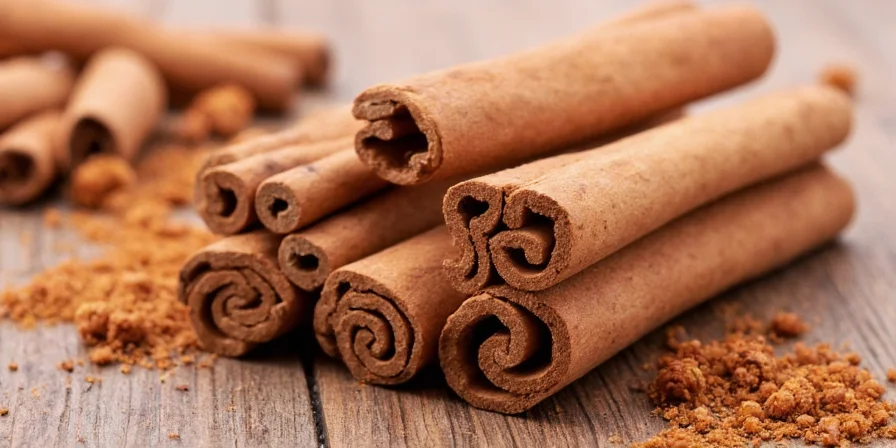Ceylon cinnamon is the only type safe for daily consumption due to its negligible coumarin levels. If you use cinnamon in coffee, oatmeal, or smoothies regularly, switching to Ceylon prevents potential liver concerns while delivering superior flavor. This guide reveals exactly how to identify authentic Ceylon, avoid dangerous Cassia confusion, and maximize health benefits—backed by EFSA safety thresholds and practical store verification techniques.
Table of Contents
- Ceylon vs Cassia: What's the Critical Difference?
- Why Daily Cassia Use Poses Health Risks
- How Much Ceylon Cinnamon Is Safe Daily?
- 3-Step Verification: Spot Real Ceylon in Any Store
- Smart Culinary Applications: When to Use Each Type
- Your Action Plan for Safe Cinnamon Consumption
- Critical FAQs Answered by Food Safety Standards
Ceylon vs Cassia: What's the Critical Difference?
These aren't just flavor variations—they're chemically distinct products with divergent health implications:
- Ceylon Cinnamon – "True cinnamon" from Sri Lanka with 0.017 mg/g coumarin. Forms delicate multi-layered quills that crumble easily. Citrusy, complex flavor ideal for daily use.
- Cassia Cinnamon – Market-dominant "regular cinnamon" containing 1,900-4,700 mg/g coumarin (280x higher). Features a single thick, rigid bark layer. Spicy-sweet intensity suitable only for occasional baking.

Why This Distinction Is a Health Necessity
While both offer antioxidants, coumarin content creates completely different safety profiles. The European Food Safety Authority (EFSA) sets safe limits at 0.1 mg coumarin per kg body weight daily. For a 70kg adult, that's 7mg max. Crucially, one teaspoon of Cassia (2.6g) contains 5-16mg coumarin—exceeding safe limits in a single serving. Chronic consumption risks liver strain, while Ceylon's trace coumarin allows unlimited daily use.
Why Daily Cassia Use Poses Health Risks
EFSA and German Federal Institute for Risk Assessment data reveal critical thresholds:
| Measurement | Ceylon Cinnamon | Cassia Cinnamon |
|---|---|---|
| Coumarin Content | 0.017 mg/g (safe for daily use) | 1,900-4,700 mg/g (exceeds limits) |
| Daily Safe Limit (70kg adult) | Unlimited consumption | Max 1.5g (½ tsp) weekly |
| Typical Grocery Store Product | 5-10% of cinnamon sold | 90-95% of cinnamon sold |
| Label Identification | "Ceylon" or "Sri Lankan" specified | Rarely labeled as Cassia |
Real-World Risk Assessment
Occasional Cassia use in baking (1-2x/month) poses negligible risk. Danger emerges with daily habits like adding to coffee, oatmeal, or smoothies. A single daily teaspoon of Cassia delivers 3.5-11x the EFSA weekly limit over time. Ceylon eliminates this concern while offering more nuanced flavor preferred in European and Middle Eastern cuisines.

How Much Ceylon Cinnamon Is Safe Daily?
The answer is straightforward: Ceylon cinnamon has no established upper consumption limit due to negligible coumarin. Research shows optimal benefits at:
- Daily maintenance: ½-1 teaspoon (0.5-2g) in coffee, oatmeal, or smoothies
- Therapeutic use: Up to 2 teaspoons (3g) daily for blood sugar support
- Maximum tolerance: Most tolerate 3+ teaspoons without issues
Cost vs. Health Investment Analysis
While Ceylon costs 3-5x more than Cassia, the health value outweighs expense. Replacing one weekly coffee shop habit ($4) covers the annual Ceylon premium for daily use. View this as preventive healthcare—avoiding potential liver monitoring costs from chronic Cassia consumption.
3-Step Verification: Spot Real Ceylon in Any Store
Most grocery stores sell Cassia mislabeled as "cinnamon." Implement this foolproof identification system:
- Physical Inspection: Ceylon forms soft, multi-layered scrolls (like rolled newspaper) that crumble between fingers. Cassia is a single hard tube requiring significant force to break.
- Color Check: Ceylon appears light tan to pale brown; Cassia shows deep reddish-brown.
- Label Verification: Only trust products explicitly stating "Ceylon" or "Sri Lankan." "Organic" or "Mexican cinnamon" labels typically indicate Cassia.

When buying online, verify these three elements:
- High-resolution images showing quill structure (not just powder)
- Third-party lab test results for coumarin content
- Direct sourcing from Sri Lankan cooperatives
Smart Culinary Applications: When to Use Each Type
Maximize both flavor and safety through strategic application:
Daily Health-Optimized Uses (Ceylon Only)
- Morning coffee or tea (½ tsp stirred in)
- Oatmeal, yogurt, or smoothie additions
- Lightly spiced fish or poultry rubs
- Daily spice blends for metabolic support
Special Occasion Uses (Cassia Acceptable)
- Apple pie or snickerdoodle baking (¼ tsp per recipe)
- Mulled wine or chai requiring intense spice
- Game meat rubs where strong flavor cuts richness
- Occasional holiday recipes (1-2x/year)

For holiday baking, combine ¾ tsp Ceylon with ¼ tsp Cassia—maintains signature warmth while reducing coumarin exposure by 75% compared to full Cassia recipes.
Your Action Plan for Safe Cinnamon Consumption
Implement this immediate protocol based on EFSA safety thresholds:
- Daily use (coffee/oatmeal/smoothies): Switch exclusively to verified Ceylon
- Weekly baking: Limit Cassia to 1.5g (½ tsp) total per week
- Supplement users: Verify "Ceylon" on all cinnamon supplements
This isn't about eliminating cinnamon—it's about enjoying this beneficial spice sustainably throughout your lifetime. The true mark of quality isn't just flavor intensity, but the ability to consume without health trade-offs. Ceylon delivers both safety and superior culinary sophistication historically preferred where spice subtlety matters.

Critical FAQs Answered by Food Safety Standards
How can I verify Ceylon cinnamon at the store in 10 seconds?
Bend the stick: Ceylon forms delicate multi-layered quills that crumble easily when flexed. Cassia remains rigid and snaps cleanly. If it resembles rolled newspaper, it's safe Ceylon; if it's a solid tube, it's high-coumarin Cassia.
Does "organic" cinnamon guarantee it's safe for daily use?
No. Organic certification only verifies farming methods, not botanical variety. Over 90% of organic cinnamon sold in supermarkets remains high-coumarin Cassia. Always check for "Ceylon" or "Sri Lankan" on packaging regardless of organic status.
Can I safely use Cassia in my weekly baking routine?
Yes with strict limits: The EFSA safe threshold allows maximum 1.5g (½ tsp) of Cassia weekly for a 70kg adult. One teaspoon exceeds weekly limits. For frequent bakers, substitute 75% of Cassia with Ceylon to maintain flavor while staying within safety margins.
Why don't stores clearly label cinnamon types?
Current food regulations don't require botanical differentiation—"cinnamon" legally covers both varieties. Cost-driven retailers default to cheaper Cassia without disclosure. This regulatory gap makes consumer verification essential for daily use safety.
How quickly do coumarin effects manifest from daily Cassia use?
No immediate symptoms occur, but liver enzyme changes may appear after 6-12 months of daily teaspoon consumption. The risk is cumulative and often undetected until routine blood work. Switching to Ceylon immediately eliminates future risk accumulation.











 浙公网安备
33010002000092号
浙公网安备
33010002000092号 浙B2-20120091-4
浙B2-20120091-4